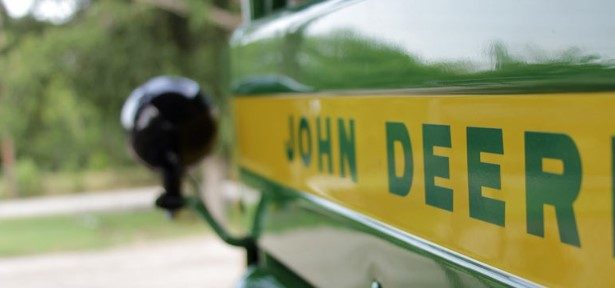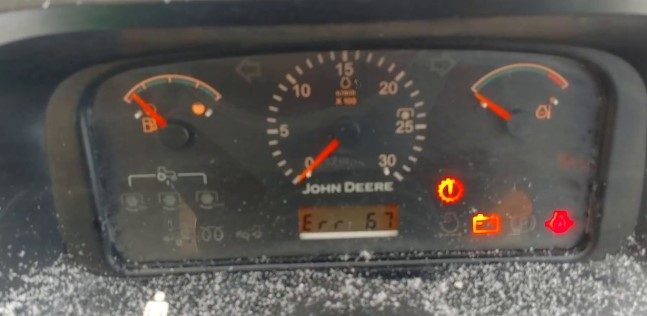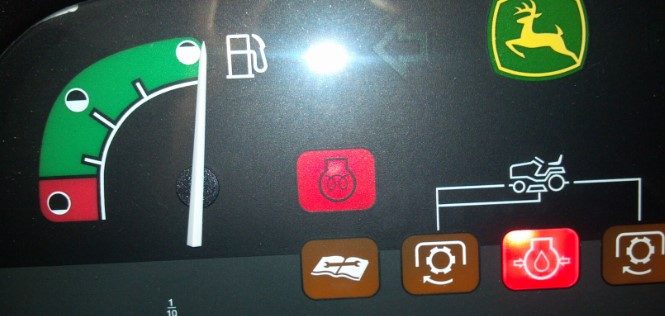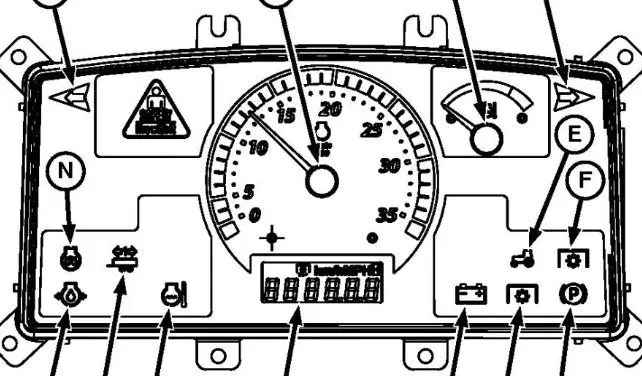When you're out on the farm, the last thing you want to worry about is deciphering your John Deere tractor dashboard symbols. John Deere understands this and has designed its tractors with easy-to-understand symbols. This blog post will review some of the most common dashboard symbols found on John Deere tractors. From engine lights to hydraulic fluid levels, we'll make sure you know what everything means.
👀Look at this: John Deere Indicator Warning Lights Codes
🚜John Deere Tractor Dashboard Symbols Overview

Check the entire list according to the numbering in the image.
- Stop the engine immediately if you ever see the red "STOP" light flashing. It indicates a serious malfunction. You'll also see one of the other lights (7, 8, 9, or 10) to tell exactly which malfunction caused the light to flash.
- This light will turn yellow when indicator lights 7-14 are on. It can also mean that the handbrake is engaged while the engine is running, and the gears are neutral. Naturally, indicator light 6 should also be on. If both lights remain on with the handbrake disengaged, something else may be wrong.
- This light will flash when something is wrong with the electric component associated with the buggy's hydraulic system or transmission. You'll need to get it serviced as soon as possible.
- On tractors with AutoPowr transmission, this LED light comes on when the key is turned one position to the right. Please wait for it to go out before starting the engine.
- Your hazard lights are flashing. A little tail light is just like a car's hazard lights.
- Your car is in gear with the break-off, and the engine is running. You might also hear a warning sound in some models.
- Your car is overheating. Turn the engine off right now, then get it serviced. If the Stoplight is also on, turn it off immediately. The situation is urgent.
- Your transmission or hydraulic oil temperature is too high! Please take it in for service immediately. If your Stoplight is also on, let it cool off and shut your engine off immediately. It's a critical situation.
- Your transmission/hydraulic oil pressure is too low. Take the vehicle in for service immediately. If the Stoplight is also on, shut off the engine IMMEDIATELY. This is a critical situation.
- This is your engine oil pressure warning light. If it came on while the engine was running, turn off it and use the oil dipstick to check your oil level. Add more oil or get your car serviced immediately. If the Stoplight is also turned on, shut the car off IMMEDIATELY. The situation is urgent and requires immediate attention.
- These lights have a high-beam setting.
- This is an alternator indicator light. You'll need to check your alternator when it comes on while the engine is running. After reviewing the cables, bring them in for service if necessary.
- Your air cleaner is approaching the end of its life, and it's time for a new one. Cleaning your air filter will only get you so far before it needs to be replaced.
- This light means your transmission oil filter is clogged or the oil temperature is too low. Bring it in for service.
- If you have a PowrQuad Plus, AutoQuad II, or AutoPowr transmission, this light could mean your information needs service.
- Your turn signals are on, or your hazard lights are on.
- The hazard lights on your trailer are on.
See also: tractor dashboard symbols and meanings
If you're a John Deere tractor owner, it's important to know what all the symbols on your dashboard mean. This overview will help you understand the purpose of each character and what action, if any, you need to take.
The John Deere logo is the first thing you'll see on the tractor dashboard. This is followed by a series of lights and gauges that provide information about the tractor's current status.
The engine temperature gauge is located at the top of the dash. This should always be kept an eye on, as an overheated engine can cause serious damage.
Next is the fuel gauge. This tells you how much fuel is left in the tank so you can plan your next fill-up accordingly.
💥See also: John Deere Gator 825i Warning Lights
The tachometer measures the speed of the engine's crankshaft rotation. Monitoring is important so you don't overwork the engine and cause damage.
The odometer tells you how far the tractor has driven since its last reset. This can be useful for keeping track of maintenance intervals and monitoring wear and tear on the tractor.
Lastly, there is a series of warning lights that will illuminate if there are any issues with the tractor. These include lights for low oil pressure, high coolant temperature, and charging system problems. If any of these lights come on, investigate the issue as soon as possible to avoid further damage to the tractor.
✨What do the Colors Of John Deere Tractor Dashboard Symbols Mean?

The colors of John Deere tractor dashboard symbols can be very confusing to those who are not familiar with them. Here is a breakdown of what each color means:
Red: This is the color of warning lights and indicates a problem that needs to be addressed immediately.
Amber: This is the color of caution lights and indicates a potential problem that should be checked out immediately.
Green: This is the color of normal operation lights and indicates that everything is working as it should be.
See also: Mahindra Tractor Warning Lights Meaning
❗Most Important John Deere Tractor Dashboard Symbols

The John Deere tractor is a workhorse on the farm, and its dashboard is full of symbols that provide important information to the operator. Here is a rundown of the most important characters found on the John Deere tractor dashboard and what they mean:
- The Engine oil pressure warning light comes on when the engine oil pressure is low. It's important to check the oil level and add oil when this light comes on if needed.
- Coolant temperature warning light: This light comes on when the coolant temperature gets too high. It's important to stop the tractor and let it cool down when this happens.
- Battery charge warning light: This light comes on when the battery isn't properly charged. It could indicate a problem with the alternator or battery cables.
- The transmission temperature warning light comes on when the transmission fluid temperature gets too high. It's important to stop driving and let the transmission cool down when this happens.
- Fuel level gauge: This gauge shows how much fuel is in the tank. It's important to watch this so you don't run out of power while working.
See also: Kubota Dashboard Warning Lights and Symbols
📌John Deere Tractor Dashboard Tips

The John Deere tractor dashboard contains symbols and lights that provide information about the vehicle's status. While some may be self-explanatory, others can be more difficult to understand. Here are some tips for understanding the John Deere tractor dashboard symbols:
- The engine oil pressure light is one of the most important symbols on the dashboard. This light comes on when the engine oil pressure is low and should be addressed immediately.
- The coolant temperature light is another important symbol. This light indicates that the coolant temperature is too high and could lead to engine damage if not addressed.
- The battery charge light shows the status of the battery charging system. If this light is on, the system is not working correctly and needs to be serviced.
- The hydraulic oil level light lets you know when the hydraulic fluid level is low. This can happen if there is a system leak or the fluid has become contaminated.
If any of these lights are on, stopping operating the tractor and investigating the issue is important. With some knowledge, you can keep your John Deere tractor running smoothly for years!
🚀Recommended article: John Deere Tractor Warning Lights Meaning
John Deere tractors are some of the most popular on the market, and for good reason. They're tough, reliable, and packed with features that make them perfect for various applications. But unless you know what all the symbols on the dashboard mean, you might not get the most out of your tractor. With this quick guide, you can decode all those mystery symbols and return to work!
See also: Kioti Tractor Warning Lights, Symbols and Meanings
FAQs About John Deere Tractor Dashboard Symbols
📈How much does the John Deere tractor cost?
Prices for John Deere tractors range from Rs 4,700 - Rs 29,200.
🔧Where are John Deere tractors made?
John Deere manufactures all of their tractors in two places, with one location in Germany and one in the US. All 7R, 8R, and articulated 9R series tractors emerge from Deere's Waterloo, Iowa, headquarters plant.
👌Which is the best tractor in John Deere?
Top 8 John Deere Tractor Models
John Deere 5050 D.
John Deere 5045 D. ...
John Deere 5105. ...
John Deere 5036 D. ...
John Deere 3028 EN. ...
John Deere 5042 D PowerPro. ...
John Deere 5310. ...
John Deere 6120 B.
㊙️Are John Deere engines made in China?
Agricultural equipment manufacturers such as John Deere, who build combines and engines in China, have had to look outside of the U.S. for revenue because of slowing sales at home. European rivals have been looking to capitalize on the opportunity with their agricultural equipment experience and research-and-development budgets.
🚜What do the alert symbols on a John Deere tractor indicate?
When the red "STOP" symbol illuminates, one should immediately halt the engine. This is a signal of a grave issue. Additionally, symbols 7, 8, 9, or 10 will appear, highlighting the exact nature of the problem. Meanwhile, the flashing yellow "CAUTION" symbol is an alert when symbols 7, 8, 12, 13, or 14 activate.
🔧What does the engine diagnostic symbol signify on a John Deere machine?
The Engine Diagnostic Symbol lights up when there's an engine-related issue. One should examine the oil level and consult the Information Display for specific error messages. If required, a visit to the John Deere service center for a detailed diagnosis is recommended.
💡What could be the reason for the oil pressure alert flashing on John Deere equipment?
The most common reason, as pointed out, is a diminished oil level, possibly due to leaks from seals or gaskets or even a clogged filter. However, this flashing light might indicate deeper concerns like wear and tear in bearings, crankshaft, or the oil pump. The initial step one should take is to inspect the oil's quantity.
🔍Why did John Deere opt for the colors green and yellow?
John Deere's wife influenced the choice of green, symbolizing flourishing crops, while yellow represented crops ready for harvesting. This combination felt appropriate for farming, and there's a certain charm in spotting the green and yellow hues of John Deere in the fields, especially when they're operational.
Was this page helpful?




John Deere has a large number of tractor models, including the most popular ones such as: 3520, 3640 and 4840. The 3520 is mainly used for farm work and heavy-duty tasks. The 3640 is versatile and can be used for general farm work or for more specialized purposes such as harvesting corn or wheat. It's also a good choice if you want to combine fieldwork with hay or grain. The 4840 is primarily intended for those who have a high volume of crops and require maximum productivity on their fields.